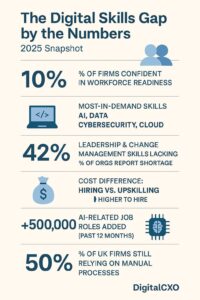Ten years ago, digital transformation was the boardroom buzzword. Today, the transformation is here — and it’s falling flat. Why? Because the people aren’t ready.
We’ve architected dazzling cloud-native platforms, implemented Agile-at-scale frameworks, and rolled out enterprise AI copilots. But too many organizations are stuck with outdated talent models, underinvested learning strategies and a workforce that’s drowning in legacy skills.
Let’s be clear: This isn’t just a hiring problem. It’s not an “HR thing.” It’s a digital leadership failure — plain and simple.
The Data Doesn’t Lie
A new global survey by TalentGPT (reported by ITPro) should shake every Digital CXO awake. Spanning the U.S., U.K., Germany and Australia, the study found that only 10% of companies believe their workforce has the right skills for future objectives.
Among the most critical shortages? AI, data, cybersecurity and cloud proficiency. But it doesn’t stop there — leadership and change management gaps were also flagged as top concerns.
Translation? We’re trying to run 2025 strategies on 2015 capabilities. And the systems are blinking red.
Talent Isn’t Just HR’s Problem — It’s a Digital Mandate
If you think your role as CIO, CTO or CISO doesn’t include workforce transformation, think again.
Every initiative — DevOps rollout, AI ops integration, zero-trust shift — will fall flat without the human skills to drive it. Yet many tech leaders still treat talent like a handoff: Recruit some engineers, throw in a Udemy license, check the box.
But here’s the truth: If you’re not embedding reskilling, upskilling and cross-skilling into your product strategy, you’re not leading — you’re outsourcing your failure.
As digital leaders, we must reclaim our role as architects of capability — not just infrastructure.
This Isn’t Just About Tech Skills
Let me be clear: It’s not just about training more Python developers or Kubernetes admins. It’s about cultivating learning agility, judgment, collaboration and ethical reasoning. These are the muscles we need in an AI-augmented world.
The tools will change — fast. But the ability to adapt, to make decisions under uncertainty, and to navigate human-machine collaboration? That’s the foundation.
Unfortunately, many execs undervalue “soft” skills. That’s a mistake. Those so-called soft skills are what keep your transformation from derailing when the AI outputs garbage or your ML model takes on bias.
“We’ve spent the last decade measuring digital maturity by tech stack. Maybe it’s time to measure it by mindset.”
What Forward-Looking Organizations are Doing Right
Some are getting this right. Companies like Infosys and Amazon are investing in internal upskilling academies. Capgemini has built global talent frameworks to rotate employees into AI and cloud roles.
Even national governments are stepping up — Singapore’s AI-powered skills passport is helping citizens stay employable in a shifting economy.
These leaders don’t just see skills as a cost center — they see it as a competitive moat.
Your Learning Culture is Your Talent Strategy
Here’s a wake-up call: It costs three to five times more to hire externally than to grow from within. In a tight market, your employer brand can’t just be about perks and pay — it’s about growth.
Upskilled workforces move faster, deliver more consistently, and stick around longer. They’re also better equipped to handle change — because you’ve trained them for it.
Digital maturity isn’t a project — it’s a people engine. And the best organizations are learning machines.
What Needs to Change: A Digital Leadership Manifesto
Let me offer a short manifesto for every CxO who’s serious about solving this:
- Put a C-level exec in charge of skills.
Not HR — make it someone who owns digital delivery. - Tie skills to business outcomes.
Make learning a KPI that shows up in quarterly OKRs. - Invest in internal academies.
Treat them like product teams — agile, fast and budgeted. - Hold managers accountable.
If your team isn’t learning, it’s not just their fault — it’s yours. - Promote learning agility.
Celebrate the people who pivot, not just those who execute.
“Treat your workforce like a product. Ship updates, gather feedback and evolve continuously.”
The Transformation Starts Within
At every conference I moderate, every webinar I host and every panel I join, I hear the same refrain: “We’re struggling to scale digital transformation.”
Well, maybe the problem isn’t your architecture. It’s your talent architecture. Maybe the transformation you really need to lead… is internal.
Because if you want AI-ready systems, start by building AI-ready people. If you want transformation that sticks, grow digital leaders at every level.
That’s not just good business — it’s the only path forward.
Shimmy’s Sidebar: What I’ve Learned
After 12+ years interviewing the best minds in DevOps, digital transformation, and enterprise tech, one thing’s clear:
Technology doesn’t transform companies — people do.
And if we don’t give those people the skills to thrive in a new era, the tools won’t matter.
Trust me, I’ve seen million-dollar tools gather dust because nobody knew what to do with them.

